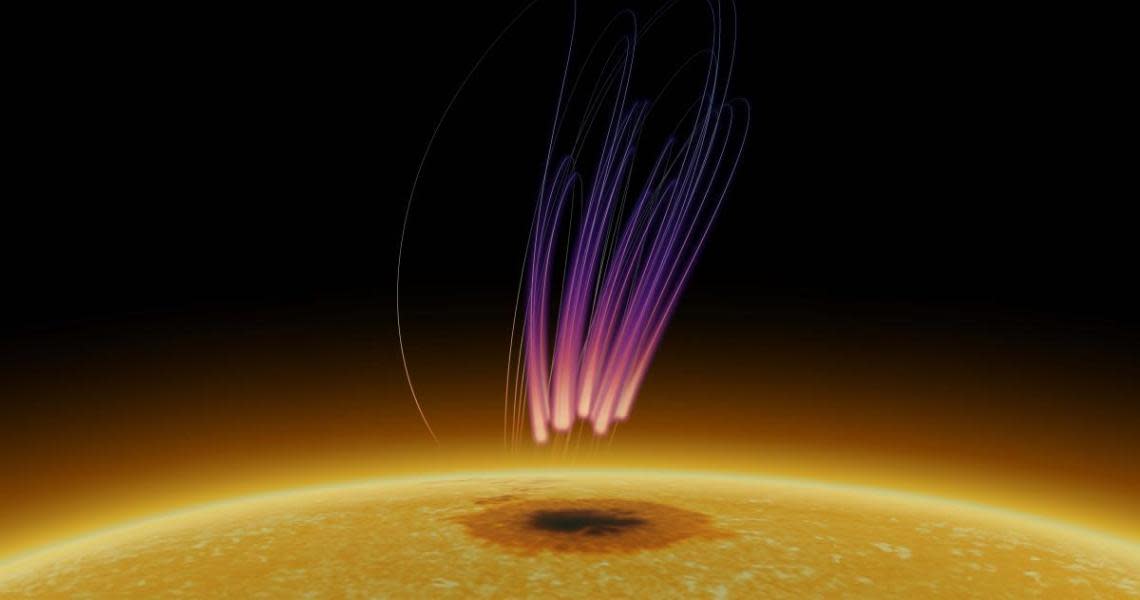'Peculiar' aurora-like radio signal from sunspot discovered for the 1st time

Solar scientists have observed a stunning display of radio waves over a sunspot, and these emissions strikingly resemble auroral displays on Earth known as the Northern Lights.
Happening around 25,000 miles (40,000 kilometers) over a dark, relatively cool patch of the sun, these "auroral" radio emissions could not only shine a light on the dynamics of intense solar radio bursts, but also on large starspots beyond our solar system. The signals were spotted by astronomers from New Jersey Institute of Technology’s Center for Solar-Terrestrial Research (NJIT-CSTR).
"We've detected a peculiar type of long-lasting polarized radio bursts emanating from a sunspot, persisting for over a week," Sijie Yu, lead author of the research and a scientists at NJIT-CSTR, said in a statement. "This is quite unlike the typical, transient solar radio bursts typically lasting minutes or hours. It’s an exciting discovery that has the potential to alter our comprehension of stellar magnetic processes."
Related: Sun breaks out with record number of sunspots, sparking solar storm concerns
The best-known auroral light shows are those over Earth, known as the Aurora Borealis or Aurora Australis, aka the Northern and Southern Lights — but auroral displays are also seen over other solar system planets like Jupiter and Saturn, and even over distant stars.
These displays above Earth occur when solar activity affects the planet's magnetosphere, creating streams of charged particles that hit atoms in the atmosphere such as oxygen and nitrogen. When some of these particles, namely electrons, accelerate down the magnetic field lines of the Earth, they can generate intense radio emissions at frequencies around a few hundred kilohertz.
According to the team, these newly observed sunspot radio emissions form where the sun's magnetic field lines are particularly strong. The emissions are also different from previously known solar radio noise storms in terms of their spectrum — the range of wavelength category they span combined with how long those wavelengths last.
How do sunspot auroras differ from Earth’s auroras?
The team thinks this new aurora-like phenomenon emerges due to high-energy electrons getting trapped within solar magnetic fields that converge, with cooler and intensely magnetic areas of sunspots providing a favorable environment for the occurrence of what are known as electron-cyclotron maser (ECM) emissions.
"However, unlike the Earth’s auroras, these sunspot aurora emissions occur at frequencies ranging from hundreds of thousands of kHz to roughly 1 million kHz — a direct result of the sunspot’s magnetic field being thousands of times stronger than Earth’s," Yu said.
The team behind these observations also saw that the timing of these radio bursts doesn’t seem to be tied to the timing of solar flares.
"Instead, sporadic flare activity in nearby active regions seems to pump energetic electrons into large-scale magnetic field loops anchored at the sunspot, which then power the ECM radio emission above the region," research co-author and University of Applied Sciences Northwestern Switzerland scientist Rohit Sharma said.
The rotation of the sunspot auroras is in sync with solar rotation with Yu describing this as a "cosmic lighthouse effect."
Related Stories:
— Perseverance Mars rover spies big sunspot rotating toward Earth (photos)
— Powerful solar storm supercharges auroras and STEVE around the world (photos)
— Infrared aurora on Uranus confirmed for the 1st time
"As the sunspot traverses the solar disk, it creates a rotating beam of radio light, similar to the modulated radio aurora we observe from rotating stars," Yu continued. "As this sunspot radio aurora represents the first detection of its kind, our next step involves retrospective analysis. We aim to determine if some of the previously recorded solar bursts could be instances of this newly identified emission."
The team’s observations link solar behavior to magnetic phenomena around other stars. Eventually, such studies could lead solar physicists to rethink current models of stellar magnetism.
"We’re beginning to piece together the puzzle of how energetic particles and magnetic fields interact in a system with the presence of long-lasting starspots, not just on our own Sun but also on stars far beyond our solar system," research co-author and NJIT solar scientist, Surajit Mondal, said in the statement.
The team’s research was published Monday (Nov. 13) in the journal Nature Astronomy.

